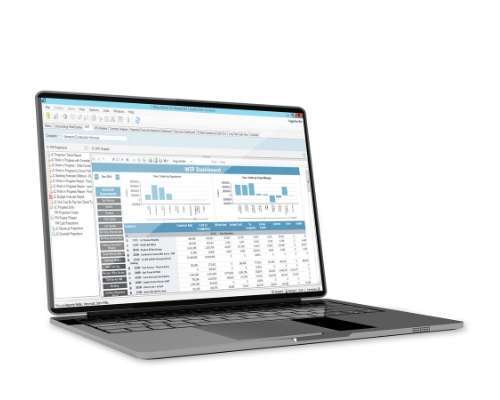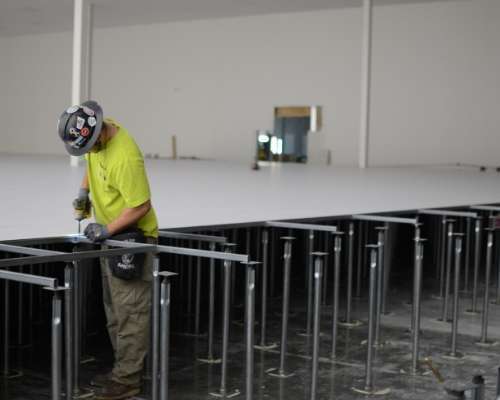6 Minute Read
February 21, 2019
0%

I recently had the opportunity to chat about modernizing construction operations with Jim Voss, CFO and Lindsey Jones-Robinson, data systems manager with Portland, Ore.-based Advanced Technology Group (ATG). An architectural and mechanical union contractor, the company specializes in general commercial and industrial contracting, with special focuses in the data and semiconductor and medical industries.

The company recently celebrated 30 years in business and now has regional offices in Washington and Arizona, but does work throughout the United States and internationally. When it’s older, disconnected construction management systems just weren’t keeping up with the company’s growth demands, ATG chose to upgrade to a cloud-based solution with the integrated Trimble Construction One suite of construction solutions. Voss and Jones-Robinson both graciously shared their journey with me. Here’s just some of what they had to say:
Jim: Our old system was restricted to just the accounting team. We were running either home-grown systems or extracting data and doing reporting out of the accounting system to provide job cost and performance information to the rest of our team. We had a separate system for labor tracking and projections. We had another system for time card entry, which would then get converted into a file that we’d have to upload into the accounting system. All of this was really challenging.

Lindsey: Yes, for time capture, we couldn’t find a (third-party) program that worked correctly with the accounting system we were using, so it was an in-house system. Paper time cards were turned in to an admin, who was manually entering them. Then there was a transfer to a background program that converted the data into a .csv file, which would then be imported into and checked within the ERP. Then it went over to processing for actual payroll. Then you add in that we’re a union contractor, having to meet those deadlines every week, it made it even more difficult. Then there were other third-party, “so-called” integrated software solutions we were using from the project management standpoint that never uploaded correctly, didn’t “talk” to the other software correctly. It got to the point where the only thing our project teams cared about in the accounting realm was, “does my contract value match, does my billed amount match, and my costs as a whole,” and they were tracking these separately within spreadsheets. Trying to learn someone else’s separate processes and where they were in the project was super difficult. With Trimble Construction One, we converted nine different programs. whether they were purchased programs or in-house developed programs, into one solution with Trimble Viewpoint.
Lindsey: When we first began this process, we were looking for a time entry solution that integrated with our old system. When we had a hard time finding that, we moved to evaluate all of our software systems. We spent six months where we talked to current users of both our main ERP and other systems to find out how their processes were and what their feelings were. We developed a checklist of things we were looking for in a new system. Once we decided to move to Trimble Viewpoint and Trimble Construction One, we spent another six months in advance of our go-live date working with consultants and Viewpoint trainers and making sure we were set up with everything the way we wanted – the right way for our business.

Jim: Through our evaluation process, having a team of people that represented different areas of our company really gave us a lot of confidence that when we did select Trimble Viewpoint, we were making the right choice. We knew there still might be some push back and challenges during implementation, but we prepared for it. And, we were so frustrated with our old systems, we knew we needed to make a positive change. By taking our time with this, there were a lot of opportunities to give folks access to the new Trimble Construction One solution and get a feel for it. So, when it came time to go live, it wasn’t something brand new. The data had been migrated and audited to make sure it was complete, and our teams really were ready to start using the new system. We’re proud we were able to set a go-live date and stick to it, implementing on time and to plan.

Jim: One of the biggest advantages has been the consistency of how people log in and the consistency of connectivity. In our old systems, we were working from a server located here at our central office. It really put our remote teams at a disadvantage because for many of the programs they would need to use a remote desktop connection to log in. They would have all kinds of resolution issues and connectivity issues. It was a constant struggle. The tasks where they’d have to log into systems remotely would consistently be late, or became the lowest priorities because it was such a chore to do them. Now, it doesn’t matter where you are — whether you’re in the main office, working from the job trailer, in a remote office or working from home — that connection is identical and consistent. It makes it much easier to provide end user support. This has significantly reduced the amount of downtime and frustrations that remote workers were having on a daily basis. With Trimble Construction One, the products work well with tablets and mobile devices. That’s been a big help for our team members who spend more time on the construction site. They’re able to get in, see their information, produce the forms and reports that they’re accountable for, while using the tools they’re most familiar with. We’re receiving a lot of positive feedback and it’s helping us continue to become a more mobile-friendly company.
Lindsey: The billing compiler has been an area where we’ve seen among the greatest amounts of time saved. On our large projects that we can be audited in and have to supply invoicing backup within a 72-hour period of receiving emails, it was taking us all three days — with three people — to compile all of that information. Now we can do that with pushing a button within Trimble Construction One and it takes just minutes to pull all of that together, pull it into a single PDF and get it turned over. That’s an incredible time saver.
Jim: We have a complete set of data, stored in one place that is really easy to access. That, for our company, is huge. That’s made possible by how well connected the products in Trimble Construction One are. It’s elevated the quality of the project accounting and project analysis that our project teams are able to do. Instead of them getting limited information that’s slightly out of date, they have live information that is complete. It gives them a better ability to monitor project activity and performance. Vista has a powerful projections tool, and it has really enhanced our project teams’ understanding of how original estimate, cost-to-date, billings-to-date, total projected costs, open commitments, etc. all flows through to the contract schedule and WIP schedule. That whole workflow is something they didn’t have access to prior to moving into Vista/Trimble Construction One. All of a sudden, there is a whole new world of information they can use to manage their jobs effectively.
6 Minute Read
February 21, 2019
7 Minute Read
December 14, 2022
7 Minute Read
May 4, 2021